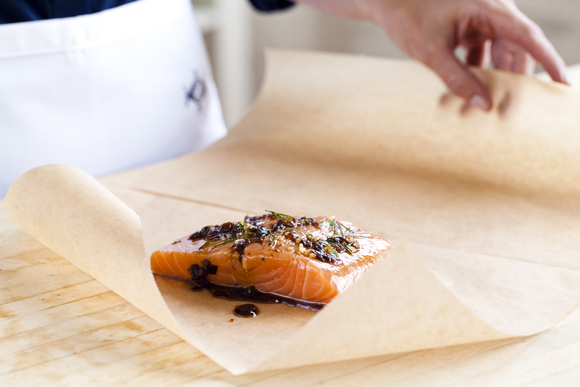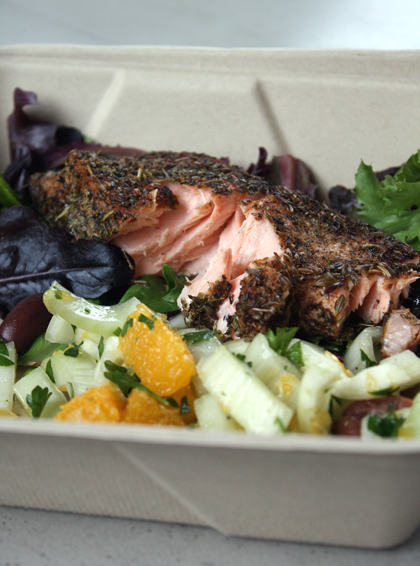A New Farmed Salmon
When it comes to deciding whether to eat farmed salmon, the choice is not always clear cut.
Sure, farmed salmon in general gets a bad rap — and deservedly so. The Environmental Defense Fund issued a health advisory for farmed salmon because of high levels of PCBs. It takes about three or four pounds of wild feeder fish to grow one pound of farmed salmon. Waste from open-water pens pollutes surrounding ocean waters. And the farmed fish can sometimes escape, posing potential problems for wild fish populations that can be affected by their parasites or diseases.
U.S. farmed freshwater coho salmon, though, gets a “Best Choice” recommendation from the Monterey Bay Aquarium’s “Seafood Watch” guide because it is farmed in inland tanks, lessening the potential spread of disease and pollution. They also require less wild feeder fish to grow.
Some chefs also favor a Scottish salmon, marketed as Loch Duart, which is farmed in the waters off the northwest coast of Sutherland. It’s billed as a sustainable alternative, but it, too, relies on feed made of fish meal and oil.
Now, into the fray comes a new farmed salmon, this one from the waters of Patagonia, Chile.
Known as Verlasso Salmon, this new farmed Atlantic salmon just launched last summer and is starting to show up in markets nationwide. Berkeley Bowl, which started carrying it in February, is the only retailer in the Bay Area selling it so far. You can find it at the seafood counter at both of its Berkeley stores for $14.80 per pound.
What makes this farmed salmon different?
Instead of needing three or four pounds of wild feeder fish to grow one pound of farmed salmon, Verlasso has developed a process to get that down to a one-to-one ratio. How? By supplementing the fish meal feed with a special kind of yeast that is rich in omega 3s, which salmon typically get from ingesting other fish. In the future, the company hopes to get that ratio down even more, so that the farmed salmon can be raised with little to no fish meal at all, says Scott Nichols, director of the Delaware-based Verlasso.
The fish spend the first part of their life in raised, indoor tanks on land. Once they reach 9-12 months old, the fish are put in pens in the ocean that employ a double-net system to minimize escapements, as well as protect the fish from predators, Nicholas says.
While wild salmon get their characteristic color from carotenoids in the krill they eat, farmed salmon get it from their feed pellets. Verlasso is no different. Its farmed salmon get their rosy-orange blush from algae in the pellets.
As for the taste? Nichols and Verlasso Director Allyson Fish (yes, that is her real name) met me at Berkeley Bowl one recent morning with fillets of the salmon that had been cooked by a nearby caterer so that I could try it first-hand.
The flavor is milder than that of wild salmon. It has the rich, unctuous mouthfeel you expect from salmon, but it’s not as flaccid as most farmed salmon. Indeed, Nichols says, Verlasso salmon’s fat content is about 12 percent, closer to that of wild salmon (typically 8- to 10-percent) rather than other farmed salmon (usually 16- to 18- percent).
For those who have sworn off farmed salmon of any kind, Verlasso may yet be sustainable enough to sway you.
But one thing’s for sure: This new salmon has definitely added food for thought.



I’ve had it and think it is yummy. My hubby is a huge salmon aficionado and he thinks it is really good.
I bet it tasted wonderful! That dish looks ever so scrumptious.
Cheers,
Rosa
Sounds like a great alternative when wild salmon’s not in season.
I love salmon! But yeah, I hate farmed salmon mostly because of the flaccid texture you referred to. This sounds great but I hope they’re eventually more available everywhere. Why can’t these products get into the mainstream stores? Sigh.
Wow– that looks delicious! I wish Berkeley bowl was closer so it would be easy to go out and get some!
Yes please! I’ll have some of that!
Look at how beautifully pink those insides are.
Tha salmon piece looks so tasty even that it is farmed salmon!
Hello,
What is the seasoning in the first picture of the article. Looks interesting and worth a try.
thanks
I’m from the Atlantic coast of Canada and fish was a part of our diet. I will not eat farmed fish in any form. There are lots of great wild or even trout alternatives, it’s time to give salmon a rest.
Much agreed, Ayngelina – I never purchase farmed fish. To a certain degree, I’m always wary of the broad use of “sustainable” as well. Would rather just stick with “wild”, plain and simple.
That “special kind of yeast” is a GMO feed. Don’t know if you’re being kind to Verlasso by being vague or Verlasso wasn’t forthcoming about this special feed, but it’s an important tidbit of information left out of this review.
Boldski: I asked the Verlasso reps if there was anything genetically modified about this salmon. They said there wasn’t. But if you know otherwise, I’d love to hear more.
P.S. Here’s the link to the story that Boldski was referencing: http://www.greenbiz.com/blog/2013/03/11/verlasso-salmon-farming?utm_source=feedburner&utm_medium=feed&utm_campaign=Feed%3A+greenbuzz+%28GreenBiz+Latest+News%29
Greetings, Boldski and Foodgal – Allow us to clarify any outstanding questions you may have about Verlasso’s revolutionary approach to feeding our salmon.
In the ocean, algae produce omega-3s. The algae are consumed by small animals, which are then consumed by small fish. In this way, the omega-3s make their way up the food chain all the way to the feeder fish on which the salmon feed. At Verlasso, we have taken the genetic omega-3-producing capability of the algae and transferred it to yeast. This process is a genetic modification and we call the yeast a genetically modified microbe.
The process for growing the yeast microbes is a lot like the process of brewing beer. Our yeast is grown in stainless steel tanks and is fermented to produce a mixture rich in omega-3-abundant yeast. The result is that our yeast makes the omega-3s exactly as the algae do. To make the feed for our salmon, we then mix other ingredients such as proteins, oils and vitamins with the yeast (the yeast is less than 10% of the diet). With this menu, we ensure that our salmon continue to get the omega-3 oils that are crucial for them (and good for us). At the same time, we are dramatically reducing our dependency on wild feeder fish – an essential part of the ocean’s natural food chain that are currently being harvested at the limits of their sustainability (according to The Food and Agriculture Organization of the United Nations).
It’s important to know that Verlasso’s use of omega-3-producing yeast does not make our salmon genetically modified. The DNA of Verlasso salmon has not been altered in any way; our fish have the same genes as their ancestors. In fact, we do not favor the use of genetically modified salmon in aquaculture.
At Verlasso, our goal is to not only raise the best farmed salmon, but also to be the best salmon farmers in the world. We are proud of the significant progress we’ve made in reducing the quantity of fish needed for salmon farming, as well as other steps we’ve taken to balance our needs with the needs of the natural environment.
You can read a complete blog post about our approach at http://bit.ly/14V5YpZ. Please take a look and let us know if you have any questions.
Thanks for your time and consideration.
Scott Nichols
Director, Verlasso Salmon